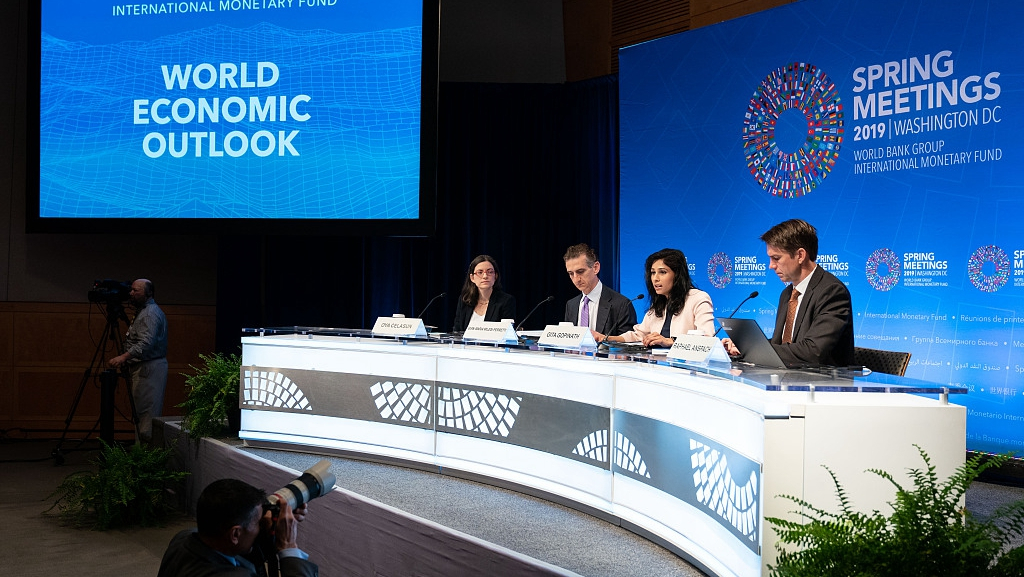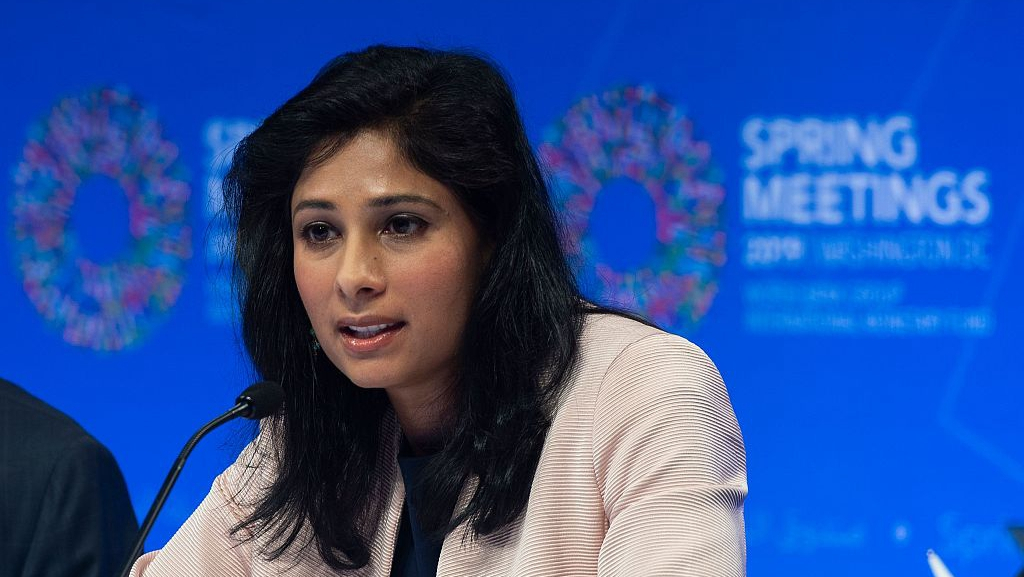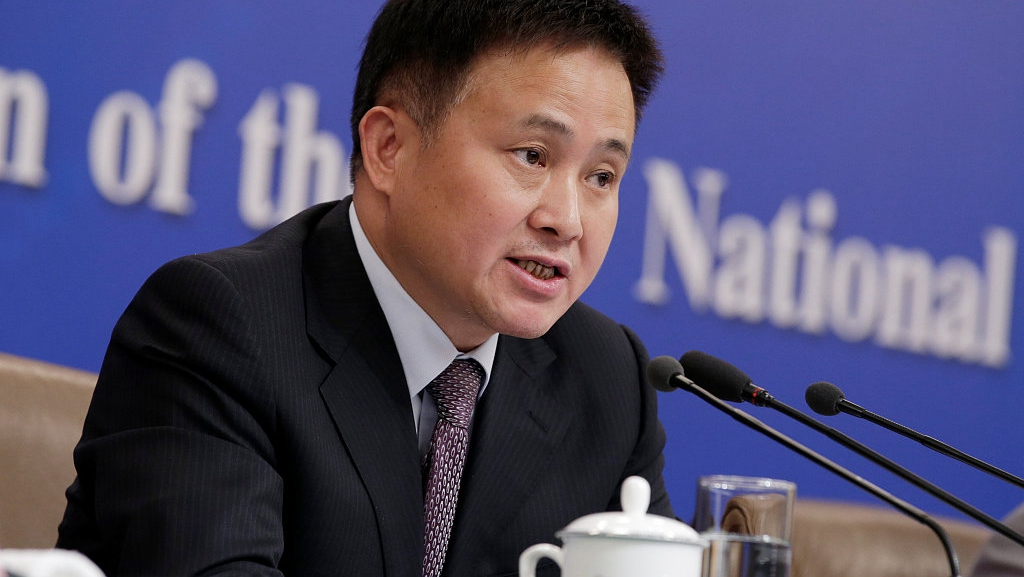
Opinion
16:33, 11-Apr-2019
Why the IMF 'downgrades' everyone but China
Wang Jianhui

Editor's Note: Wang Jianhui is the general manager of the Research and Development department at Capital Securities. The article reflects the author's opinion, and not necessarily the views of CGTN.
The International Monetary Fund (IMF) unveiled its most recent forecast for the world economic trends and potential risks in April's outlook Tuesday. Based on the concerns already mentioned in January's World Economic Outlook, such as the China-U.S. trade tension and Brexit, the global economy is projected to grow by only 3.3 percent this year after the forecast was revised down from 3.5 percent in January.
Projected growth of advanced economies including the United States, the eurozone, Japan, and the United Kingdom, and emerging economies such as India and Brazil, has been trimmed by 0.1 to 0.4 percentage point.

Gita Gopinath, chief economist and director of the research department at the International Monetary Fund (IMF), speaks during a press conference, April 9, 2019, Washington, D.C. /VCG Photo
Gita Gopinath, chief economist and director of the research department at the International Monetary Fund (IMF), speaks during a press conference, April 9, 2019, Washington, D.C. /VCG Photo
As the "silver lining behind the dark clouds," China is the only economy to be raised by a tenth of a percentage point in the 2019 growth forecast.
This subtle fine-tuning is a vote of confidence for the Chinese government's remarkable fiscal efforts to counter the internal and external downturn pressure in the medium term. The IMF may be deeply impressed one more time by the strong will of the Chinese government to stabilize the economy with powerful implementation after the 2008-2009 four trillion yuan (595.52 billion U.S. dollars) investment plan.
During the Two Sessions in March, the government announced astonishing tax and operational cost cuts for the manufacturing sector by two trillion yuan (297.75 billion U.S. dollars).
Only three weeks later, the Ministry of Finance presented the budget details for the Chinese fiscal year 2019, announcing the collection of value-added tax and personal income tax will be reduced by 2.3 percent and 7 percent respectively, compared with 9 percent and 15.9 percent actual increase in 2018.
Theoretically, the new tax code could reduce the corporate and households' financial burden by 1.02 trillion yuan (151.58 billion U.S. dollars) per year, equivalent to 1.06 percent of estimated GDP this year.
This severe cut could outshine President Trump's Tax Cut and Jobs Act 2017, which was supposed to save 144.5 billion U.S. dollars or 0.7 percent of GDP in 2018 for American households and enterprises annually.
The passage of the new Act prompted the IMF to revise the U.S. growth forecast from 2.3 percent to 2.7 percent in 2018 when the actual growth was 2.9 percent. We might argue that the IMF could be a little more conservative in the Chinese case.
The bold and creative monetary policy could be another significant reason for the IMF's relatively optimistic stance, which has repeatedly urged an accommodative policy since 2018. The People's Bank of China (China's central bank), upon sensing the potential threats of a liquidity shortage and increased funding cost, has lowered decisively the required rate of reserve for the commercial banks by 300 basis points, enabling theoretically 4 trillion yuan (595.52 billion U.S. dollars) to be utilized by the economy.
Thanks to the easy policy, the newly issued bank loan for the first two months has reached 4.12 trillion yuan (613.39 billion U.S. dollars), an unprecedented record in history, even exceeding the level in the same period of 2009 by 53 percent.

Pan Gongsheng, director of the State Administration of Foreign Exchange, answers questions on monetary policies aiming to help small and micro businesses in the Two Sessions. /VCG Photo
Pan Gongsheng, director of the State Administration of Foreign Exchange, answers questions on monetary policies aiming to help small and micro businesses in the Two Sessions. /VCG Photo
Amazingly, the quick credit expansion has not brought new troubles so far; the overall debt ratio of industrial companies was 56.9 percent in February, only 0.6 percentage point higher year-on-year.
Unlike a conventional leveraging process, China's central bank has been trying different means to "sterilize" the leverage added. The most important tactics are to replace shadow banking with compliant leverage, which can be easily monitored and managed.
From February 2018 to February 2019, the balance of newly issued loans summed to 17.32 trillion yuan (2.58 trillion U.S. dollars), up 13.7 percent over the same period of the previous year, while the balance of newly issued client-entrusted loans and institutional trust loans, two major types of the shadow banking business, declined by 623 percent and 134 percent respectively.
Secondly, the regulator managed to keep most of the incremental liquidity from the property market so that no imminent threats of asset bubbles are in sight. By the end of 2018, the outstanding personal home loans accounted for 18.9 percent of the total outstanding loan, comparing to 18.2 percent in 2017.
The 100 City Home Price Index recorded a flat growth of 4.43 percent in March, compared to 17.67 percent two years ago.
Finally, more leverage is guided to the neglected and disadvantageous groups – small and micro businesses. Their access to financing channels has been made easier and less expensive. By the end of 2018, bank loans for such enterprises reached 33.5 trillion yuan (4.99 trillion U.S. dollars); the inclusive loan totaled 8 trillion yuan (1.19 trillion U.S. dollars) growing by 18 percent over 2017, comparing the overall credit growth of 13.5 percent.
The financing cost could be as low as 3.15 percent (Targeted Medium Term Lending Facilities rate). In the future, the quantity and quality of financial service to the small and micro businesses will be included in the performance evaluation system for state-owned commercial banks.
(If you want to contribute and have specific expertise, please contact us at opinions@cgtn.com.)

SITEMAP
Copyright © 2018 CGTN. Beijing ICP prepared NO.16065310-3
Copyright © 2018 CGTN. Beijing ICP prepared NO.16065310-3